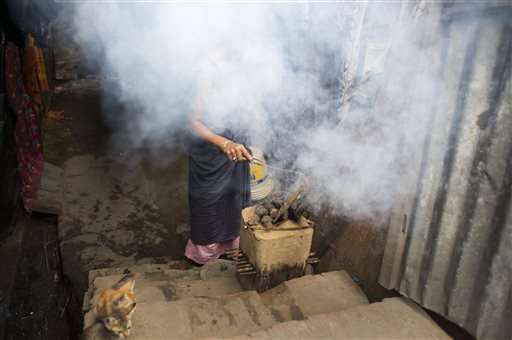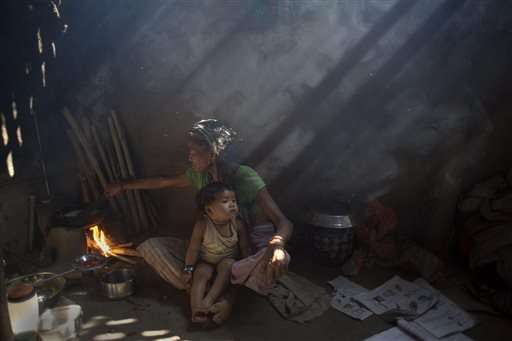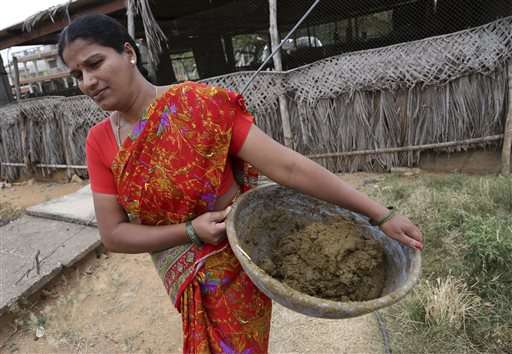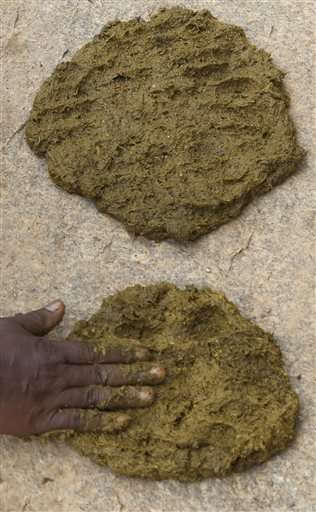Push for cleaner stoves in poor countries to cut pollution

Every evening, hundreds of millions of Indian women hover over crude stoves making dinner for their families. They feed the flames with polluting fuels like kerosene or cow dung, and breathe the acrid smoke wafting from the fires.
The smoke, containing high concentrations of tiny particles known as black carbon, is responsible for premature deaths from cancer and other diseases and is causing or exacerbating environmental problems from climate change and glacial melt to falling crop yields.
When you add up all the tiny stoves, the result comes close to catastrophic. And yet black carbon is largely unregulated and its costs unmeasured, creating a barrier to earmarking public and donor funds for underwriting the use of cleaner cookers.
That could now start to change. A team of economists, scientists and health experts working with The Gold Standard Foundation have developed a uniform way to calculate how much black carbon is released from cooking stoves that use different technologies or fuels.
It's a first and necessary step, they say, in accessing the tens of billions of dollars it will cost to provide cleaner cookers worldwide for some 2.8 billion people still using firewood, kerosene or sundried patties made of hand-packed cow dung.
"What captures media attention is the cute animals, the crying babies and the issues with great PR groups. Indoor air pollution isn't one of them," said author and economist Bjorn Lomborg, who founded the Copenhagen Consensus Center, an economic think tank specializing in climate issues. But when you crunch the numbers, "you see that some of the boring stuff really does a lot of good."
While the focus of efforts is calculating black carbon from cooking stoves, the same methods can be applied to other sources of soot including vehicles or crop burning. Those calculations can then be used by program directors to court funds, as they will be able to show how projects spare the environment from more pollution and save lives.
"The tools just haven't been there to help with policy, even though we've known about the dangers for a long time," said Owen Hewlett, chief technical officer at The Gold Standard Foundation, which released the new set of standards and calculations last week.
Indoor air pollution by black carbon is a relentless killer, causing some 4.3 million deaths worldwide every year, which is more than HIV, malaria and tuberculosis combined. Most of those deaths happen in poor countries unable to afford cleaner stoves.

Formed by incomplete combustion, black carbon is a major component in the tiny particulate matter known as PM2.5 that is now one of the most common measures for air pollution.
But it has other insidious environmental effects. It contributes to climate change, with studies suggesting it may be responsible for nearly 20 percent of global warming; it darkens the ice of the Arctic and high-altitude glaciers so that it absorbs more sunlight and melts more quickly; it messes with the weather by interacting in complex ways with clouds; and it is blotting out the sun and hurting crop yields.
A 3-kilometer-thick (2-mile-thick) layer of black carbon pollution over parts of Asia is blocking up to 15 percent of the sunlight from reaching Earth in a phenomenon known as "global dimming," according to research led by Veerabhadran Ramanathan, a climate scientist at the University of California, San Diego.
He and other scientists found the regional pollution contributed to a 36 percent drop in India's wheat yields in 2010.
Experts say that reducing the constant emission of black carbon offers immediate climate benefits, since it has a short lifespan in the atmosphere compared with carbon dioxide, which can linger for centuries.
"Financing less polluting cook stoves is one of the few win-win options for the planet," Ramanathan, who is also a director of a cookstove charity, said in a statement.
The U.N.-backed Global Alliance for Clean Cookstoves, founded by Hillary Rodham Clinton, has helped cookstove charities find some financing through grants as well as carbon credits—the so-called "currency" of the market for carbon dioxide, issued for programs that reduce greenhouse gas emissions.

In total, the 227 programs in the alliance have supplied more than 5 million new stoves. But that's still 95 million short of its 2020 goal and a tiny fraction of the total global need.
A recent study by 82 economists for Lomborg's Copenhagen Consensus estimated it would cost $137 billion to give everyone the cleanest burning gas-fueled stoves.
Every dollar of that one big investment would produce $2 in benefits such as lower medical costs, cheaper fuel and longer lives, the study shows. But that may not be the best way to spend limited resources, considering that one expense is nearly equal to the entire global development budget.

Instead, the study suggests a partial measure in spending $5 billion to provide half of those in need with more efficient stoves that still burn solid fuel, rather than gas. This would eliminate the dirtiest stoves first, and result in saving half a million lives. Overall, this approach would produce benefits of $10 for every dollar spent.
"You grab the low-hanging fruit first, such that you make a big improvement and still have funds to fix other things," Lomborg said. "If we can simply point out the small targets and show the most value for money, it's more likely they'll get funded."
© 2015 The Associated Press. All rights reserved.


















